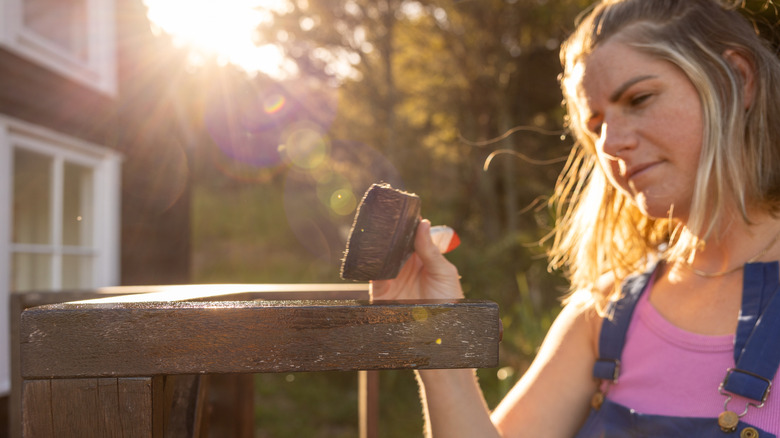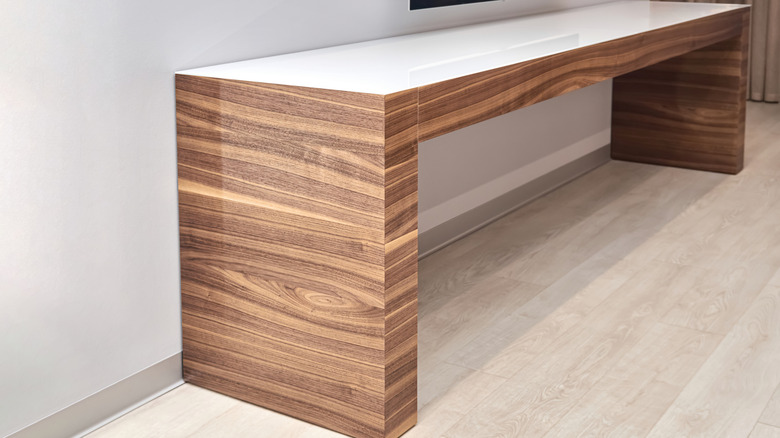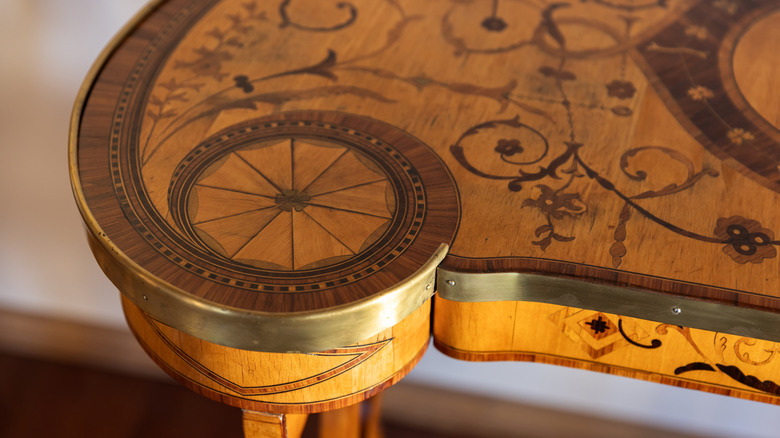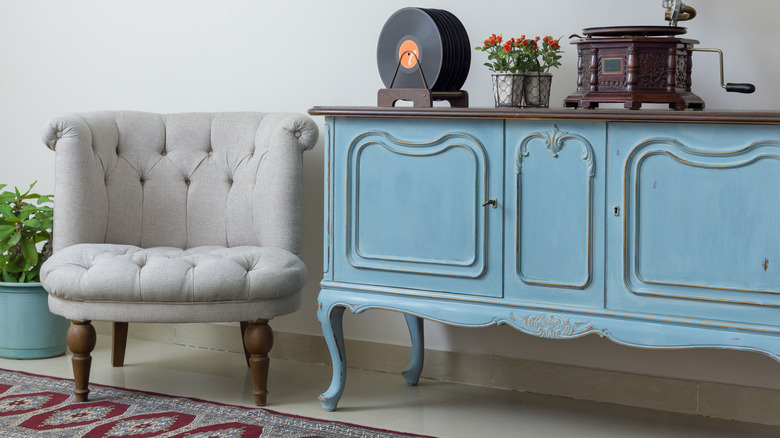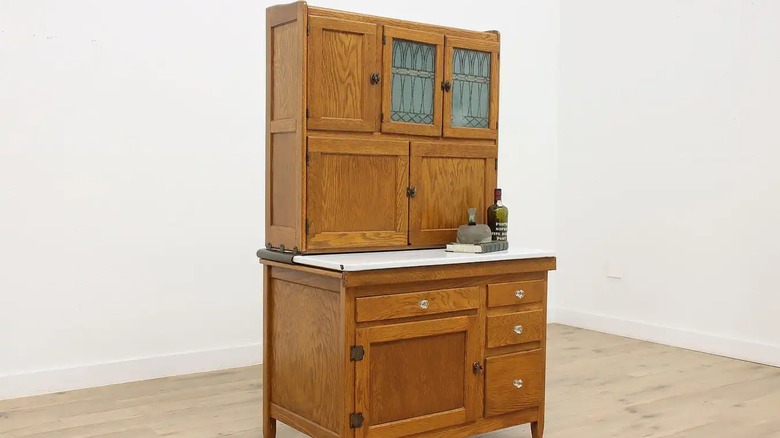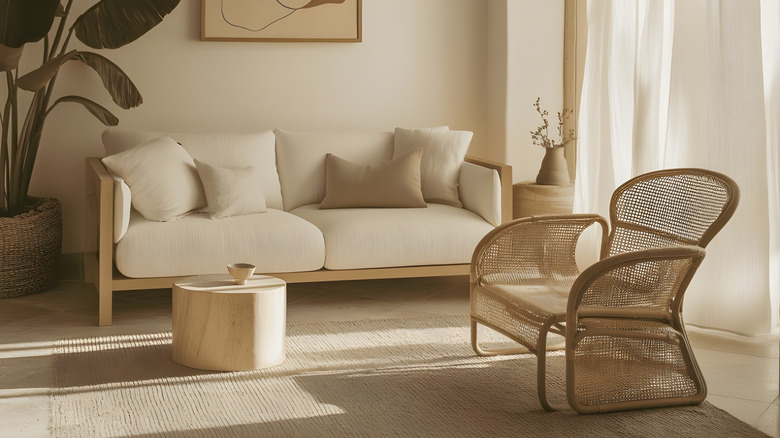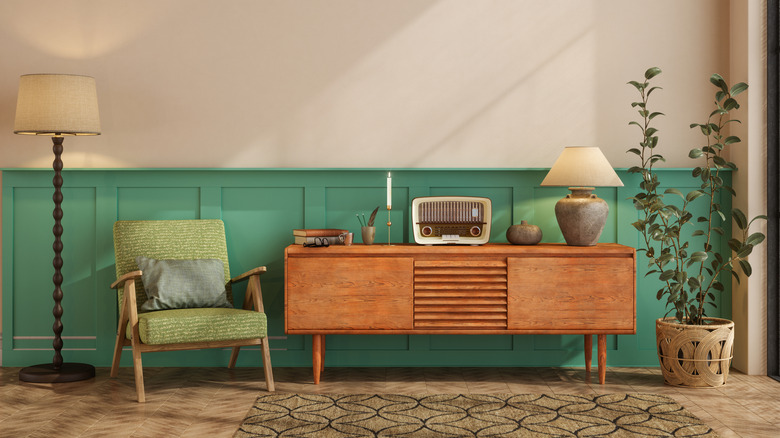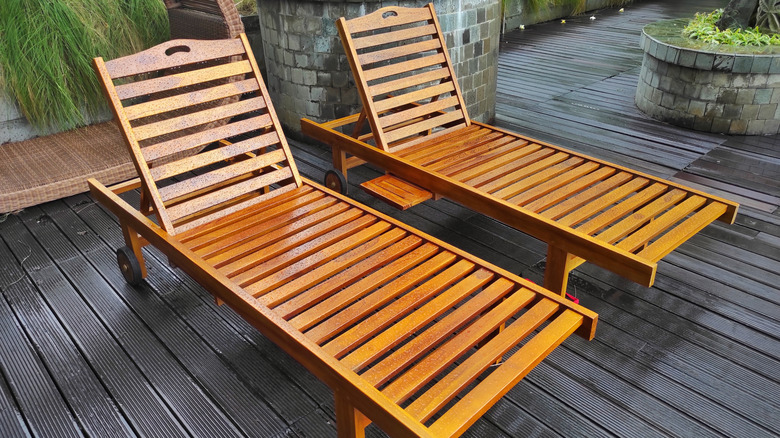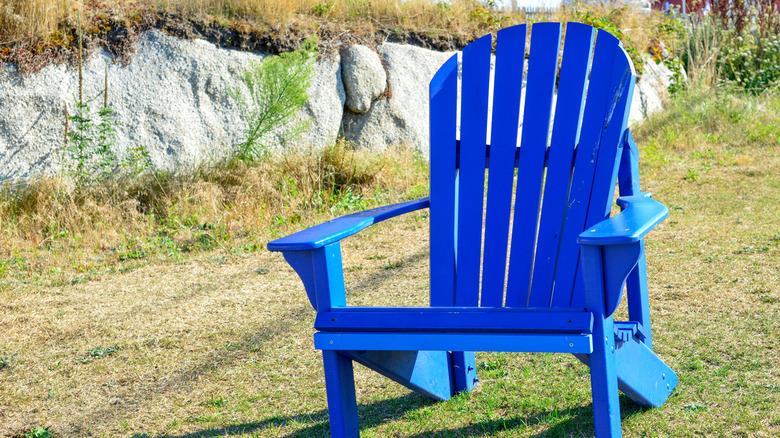Put Down The Paintbrush When It Comes To These Pieces Of Furniture
We may receive a commission on purchases made from links.
A fresh coat of paint can help you breathe new life into many things, including several furniture pieces. If you've been studying all the best tips to repaint your furniture like a pro, you might be one paintbrush and gallon of paint away from jumping right into the project. However, before you pick up that paintbrush, you should stop and decide whether the item in question should actually be painted. Otherwise, you might end up making a mistake that you'll end up regretting.
While painting is a viable — and even recommended — approach for improving the look and finish of many furniture pieces, it can be a very poor choice for others. Paint doesn't always adhere properly to certain materials, and before long may start peeling or chipping. Covering other furniture items with a coat of paint can cover up historic elements and/or decrease their resale value. To help us learn more about which pieces of furniture should not be painted, we interviewed various design and historical experts. Here's why you might want to rethink painting certain pieces in your collection.
Wood veneer is likely to get damaged during the prep stages of painting
Most solid wood furniture pieces can be painted with relative ease. However, Sarah Stafford Turner, House Digest's design historian, recommends confirming that something you think is made from solid wood actually is. "You may think you have a piece of solid wood furniture, but it's actually a very fine veneer over a base wood." If there is a veneer over the wood, Turner recommends against attempting a paint job without the necessary skills and experience. "This can be painted, but it requires special treatment and great care to not sand through the veneer layer." The chances of damaging the veneer or causing it to start flaking off are very high, which will leave you with a piece of furniture that looks very sloppy and unprofessional.
Instead of painting wood with a veneer finish, Turner says, "The best way to refinish a piece of veneered furniture that's in good condition is to clean it, lightly sand it, and stain it. If the veneer is chipped in a small spot, you may be able to fix it with some patience, care, and a good wood filler." For any larger chips from the veneer or other damage, she recommends letting a professional handle the job.
If you're going to attempt to paint this type of furniture, then you'll want to exercise extreme caution to avoid damaging the wood veneer when sanding. Use fine-grit sandpaper to gently rough up the surface before filling any imperfections and sanding again. After applying primer and the first coat of paint, you should carefully sand the surface again before recoating with paint and a polyurethane finish.
Antique wood inlay items are something you shouldn't paint on principle
Some people might have a blanket rule about never painting an antique piece of furniture. However, some exceptions may be made for items made from a paint-grade wood like pine or those with poor joinery. However, you should seriously reconsider the desire to paint any antique furniture with a wood inlay. If you're not familiar with what a wood inlay is, it is pretty much just what it sounds like: pieces of wood that are laid into a wooden base, such as a tabletop or dresser. The process of making an inlay is relatively complex, requiring the craftsman to cut a small section out of the base to match the desired design, and then carefully cutting and inserting pieces of different woods and/or dyed wood to create the intended effect.
As you can probably gather, a piece of furniture with a wood inlay showcases the hard work of an expert craftsman, which is why Stacy Verdick Case, a restorer, a vintage store owner, and the founder of Peony Lane Designs, says you should never paint these pieces. "I would be completely gutted to see someone paint over an antique inlay that was in perfect condition. It can be done but it doesn't mean it should be," she shared during an exclusive interview with House Digest. Not only are you painting over someone's hard work, these pieces are very rare today and should be treasured, not destroyed.
While you shouldn't try to paint furniture with a wood inlay, you can keep it looking its best by knowing how to properly clean it. A cleaning solution made with a few drops of oil soap, such as Murphy Oil Soap, and plain water can help you clean these pieces. After mixing the solution, dip a cotton cloth, such as one of the Nabob Cotton Cleaning Rags, into the solution, wring out all the excess liquid, and gently wipe down the entire surface. Finish up by drying the piece with another clean cloth to remove as much excess moisture as possible.
Painting vintage wooden furniture pieces can permanently cover up prized patinas and original details
We often hear about the crime it can be to paint an antique furniture piece, while generally more flexibility is given when discussing vintage pieces. However, there has been an increased interest in vintage pieces. With more and more people seeking them out — and subsequently driving up their value — slapping a coat of paint on them might be a mistake, depending on the specific item in question. Nancy Dow, an interior designer at Sierra Living Concepts, strongly advises against painting vintage furniture. "Quite a number of vintage pieces are valuable for their original finish, patina, or fittings. Even when the wood looks timeworn, it contributes to authenticity. A new coat of paint can remove decades of character — and resale value."
Dow recommends focusing on preservation rather than a full transformation and makeover to maintain the original details and vintage charm of these pieces. To achieve this goal, her advice centers around giving the piece a nice cleaning and standard polishing. She says to start with a wood-safe cleaner, such as the oil soap recommended above, to remove surface-level dirt and grime. Then, you can polish the metal hardware and restore the shine with some beeswax, such as Daddy Van's Unscented Beeswax Furniture Polish.
If you really want to give the piece a new look, consider alternatives to painting. For example, updating the hardware with some fun new pieces, such as the Zernmiarder Vintage Drawer Pulls, could have a transformative effect that doesn't impact the original construction or finishes.
Immigrant trunks and other milk-painted pieces should be left with their historic finish
If you've learned how to successfully buy antique furniture for your home, then you might have some historic immigrant trunks or other milk-painted pieces in your collection. Because these items are already painted, you might just assume that you can paint over them without doing any harm. Unfortunately, according to two of our experts, such a move would be a big mistake.
Todd Harmon, co-founder at Harmonia Living, said, "It might be shocking to advise not to repaint an already-painted antique, but older milk or lead-based finishes tell a story and in many cases, the patina adds historical and collector value. Slapping on chalk paint can make it look generic and erase the authenticity." Stacy Verdick Case agrees and says that she would even consider such an act a crime, since you're covering history. "Many have been painted with the year the previous owner traveled to their new home," she shared when discussing immigrant trunks.
Since the milk paint finish adds to the charm of these pieces, you shouldn't cover it up. However, if you're worried about it chipping off or getting more damaged than it already has over the years, Harmon offers a solution. He says, "Stabilize any flaking with a conservation-grade sealant and clean it gently. Let the aged charm show through — it is often more beautiful than anything fresh paint could achieve."
Painting enamel-top Hoosiers and tables steals their vintage charm and usability as prep surfaces
If you have a Hoosier — an antique cabinet with a pull-out countertop surface, drawers, and upper cabinets — or a table with an enamel top, Case says you should keep your paintbrush far away from them. "Enamel pieces are usually white with a painted edge (red or black typically). Painting the enamel makes the surface unusable as a prep surface and takes away from what makes the pieces special," she explains.
Instead of trying to paint over the enamel finish, consider restoring it. This will not only maintain the original charm of the piece, but it will also allow you to continue using it for food prep. Before doing anything to repair the surface, you'll want to give it a good cleaning using a kitchen degreaser, such as the Simple Green All Purpose Cleaner Concentrate. After ensuring that the surface is completely dry, you can repair small chips with an enamel repair kit, such as the Ankita repair kit for enamel. Finally, seal the surface, and you're all done.
Refinishing rattan furniture with paint is a recipe for flaking
With rattan furniture coming back into style, you might be thinking about giving some of your older pieces a new look with a coat of fresh paint. However, three of our experts do not recommend this. "The woven material doesn't take paint well," says Nancy Dow, "it flakes, cracks, and peels soon, especially in damp spaces such as sunrooms, or on patios. Its bumpy texture doesn't help either — there's no way for me to get smooth, even application, and still have it lay on the skin that way."
The last thing you want is to end up with a sloppy job that can't be fixed. Even if you're careful and the piece doesn't turn out completely ruined, Jamilyn Trainor, a senior project manager and the owner at Müller Expo Services International, said, "Painted rattan often looks instantly 'crafty,' not curated or curated craft."
So, you shouldn't paint your rattan furniture, but you can still clean it up and give it a bit of a refresh. "Freshen it up with a gentle wood oil or a tinted penetrating stain specifically for natural fibers," recommends Todd Harmon. "You will deepen the color without suffocating the texture."
The slick surface of melamine and plastic furniture makes it hard to paint properly
There are several reasons you might have picked out some melamine furniture pieces for your home. It is affordable and available in several colors and styles to match various design preferences. The melamine resin panels are also very durable and less likely to fade or become scratched or stained than some other materials.
However, over time, your melamine furniture may show its age. You may want to do something drastic, but Sarah Stafford Turner seriously cautions against doing so. She says, "I would not advise maintaining melamine unless you're skilled in prep and resurfacing of resins like this. It can be difficult to get paint to adhere to a melamine surface and can result in flaking."
Instead of attempting to repaint your melamine pieces, Turner explains that you could use contact paper, such as the Con-Tact creative covering, to recover the furniture. With all the color options, you could achieve the same look for the piece without pulling out the paintbrush.
If your mind's made up, then it is essential to follow the right steps. Turner says it will require a lot more time and effort on your part than would be necessary for painting other types of furniture. "You will want to create an adequately sanded base for good adhesion and use a high-quality primer and sealant," she says.
Paint can erase the key characteristics of patinated industrial metal furniture
Industrial metal furniture, such as apothecary cabinets and vintage lockers, can add to the aesthetic appeal of your space. However, because of their age, these vintage and antique pieces may be showing more signs of wear. A fresh coat of paint may be tempting, but Jamilyn Trainor urges caution. "When you paint over aged metal furniture," Trainor explained, "you are taking everything that characterizes it away, which can chip or scratch off quite fast."
That aged look is called a patina. And, unlike rusty or tarnished metal, it is not a bad thing to see on metal furniture. In fact, quite the opposite is true. Patinated surfaces enhance the character and charm of a piece. Patinas form over several years. The term refers to how the color of the surfaces changes naturally as the metal ages. Removing this would be a serious misdeed. So, instead of painting over it, proudly display that beautifully patinated piece. You can, however, take steps to protect the metal and finish. Trainor recommends using "a clear matte finish that maintains the worn look for appreciation, with a safety seal for everyday use. It is raw, timeless, and all the more tough."
Midcentury modern pieces with manufacturer labels or known designers can lose a lot of their value when painted over
If you have a piece of midcentury modern furniture, painting it might not be the end of the world. It may complement the aesthetics of your living space. However, there is one very important exception to this rule, according to Harmon. He says, "If the piece has a Herman Miller, Knoll, or even a lesser-known Danish maker's mark, painting it is the equivalent of painting over a signed artwork. You'll instantly devalue it even if it's dinged up."
So, put down that paintbrush and determine whether a famous designer made the piece. To do so, you can look for markings on the item. There might be a stamped logo or a signature hidden in an inconspicuous location, such as along the back of a desk or the underside of a table. In addition to Herman Miller and Knoll, other noted mid-century modern designers include George Nelson, Charles and Ray Eames, Arne Jacobsen, Han Wegner, and Gio Ponti.
Painting solid teak and other naturally weather-resistant wood furniture pieces defeats their purpose
Do you have a wooden outdoor patio furniture set? Are you wondering whether a coat of navy blue, sage green, or even classic white would enhance how it looks in your space? Well, before you get started, Harmon shares something that you should consider. "Outdoor furniture made of teak, ipe, or eucalyptus is prized because it weathers beautifully. Painting these woods traps moisture and ruins the very patina people seek over time." Moreover, if you do decide to paint your wooden outdoor furniture, you should expect the paint to flake sooner than it would when applied to another material. According to Harmon, the natural oils in the wood are the reason for this occurrence.
Instead of painting teak and other pieces of outdoor furniture made from the best types of wood, focus on proper maintenance to help it look its best and to protect it. Address any spills promptly to avoid moisture or dirt sitting on the surface. Once a year, clean the piece with a teak cleaner, such as the Bayes High Performance Teak Cleaner & Restorer, and leave the furniture out in the sun to dry. During the off-season, consider moving the pieces indoors or to a covered area. If this is not possible, place a protective cover over each piece to avoid damage from cold weather, ice, and moisture.
Plastic or polypropylene furniture does not take paint well and can quickly chip
Spray painting plastic or polypropylene outdoor furniture might seem like a good idea. And, initially, you might be satisfied with the results. However, that satisfaction is likely to fade. "Most paints don't bond well long-term, and any flex in the material causes immediate cracking. Even paints labeled for plastic eventually chip, especially in outdoor environments," warns Harmon.
He recommends maintaining the functionality of these pieces by using baking soda or a degreasing soap (such as Dawn Platinum dishwashing liquid) to keep them clean. He adds, "If they are an eyesore, use them as hidden layering pieces (like under a tablecloth or as backup seating) or donate them and invest in a more neutral-toned version." Anyway, plastic pieces are one example of an outdated furniture trend, so you might be better off investing in pieces made from higher-quality materials, such as fiber-reinforced concrete.
